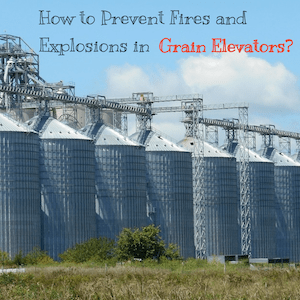Guest Author: Olusegun Bamiduro

A grain dust explosion is the rapid combustion of combustible material and fine particles suspended in the air, often but not always in an enclosure location, or confined space, such as a grain elevator.
Grain dust explosions can occur where any dispersed combustible powder is present in high enough concentrations, to ignite a dust cloud, like a grain elevator explosion. In addition, consider three critical factors of the fire triangle: the concentration of dust, the presence of an ignition source, and the availability of oxygen.
This guest post explores prevention and protection considerations in grain handling and food processing industries. The relevant risk control standards, typical process equipment, ignition sources, dust control, prevention and mitigation approaches are discussed.
Combustible Dust in Grain Handling Industries
Grain elevators and other storage facilities face a constant risk of a grain dust explosion. The very nature of using a bucket elevator, filter collectors, grain dryers, a grain elevator and other equipment to process and transport grain, create dust clouds and an environment where fuel and oxygen exist in a mechanical enclosures, which may cause a dust explosion, grain explosions, or grain elevator explosions.
When grain is suspended inside an enclosure or confined space, like a bucket elevator, filter collector, or ventilation systems, the only condition missing from the dust explosion pentagon is an ignition source. Unfortunately, ignition sources can be quite common in grain handling industries and filter collectors, grain dryers, and inside a bucket elevator are the most probable locations for primary grain dust explosions, or a grain elevator explosion.
Processing Equipment
The following is a list of processing equipment which should be included when assessing the grain explosion hazard at grain handling facilities:
- Silos
- Dust collectors
- Grinders
- Dryers
- Furnaces
- Mixers
- Pulverizing units
- Conveying systems
- Bucket elevator
Ignition Sources
Although welding and torch cutting (hot work) are the most frequently identified sources of ignition in grain handling facilities, other potential ignition sources include:
- Flames and direct heat source
- Incandescent materials
- Hot machinery surfaces
- Electrostatic sparks
- Sparks from tramp metals
- Electrical equipment sparks
- Friction sparks
- Impact sparks
- Self heating
- Static electricity
- Lightning
Control Standards
Understanding relevant standards and regulations, the Occupational Safety and Health Administration, OSHA, sets forth regulations related to grain handling facilities in the United States. These regulations, outlined in OSHA’s Grain Handling Facilities Standard (29 CFR 1910.272), cover requirements for: Housekeeping: Mandating regular cleaning to control dust accumulation to prevent grain explosions. According to an OSHA report, if five conditions are meet to have a dust explosion, they are oxygen, heat, fuel, dispersion, and confinement, these five factors make up what is known as the Dust Explosion Pentagon
The National Fire Protection Association, (NFPA), has put in place several risk control standards to serve as guidelines in food processing and grain handling industries, regarding grain dust in a grain elevator and other areas.
NFPA 61 – Standard for the Prevention of Fire and Dust Explosions in Agricultural and Food Processing Facilities
This document covers construction requirements such as egress, interior wall construction, building fire protection and equipment, including: dryers, venting and heat transfer operations, dust control, pneumatic conveying, and building fire protection.
NFPA 68 – Explosion Protection by Deflagration Venting
Venting of bucket elevators, silos, green elevator, and structures that contain or process dust such as wheat flour and other agricultural substances is covered by this standard.
NFPA 69 – Standard on Explosion Prevention Systems
This standard covers prevention of explosion by the following methods:
- Control of oxidant concentration
- Control of combustible dust concentration
- Explosion suppression
- Deflagration pressure containment
- Spark extinguishing systems
Other Standards
There are several other standards that may apply depending on the materials and equipment used at the grain handling or food processing facility:
- NFPA 484 – Standard for Combustible Metals
- NFPA 499 – Recommended Practice for the Classification of Combustible Dusts and of Hazardous Locations for Electrical Installations in Chemical Process Areas
- NFPA 654 – Standard for the Prevention of Fire and Dust Explosions from the Manufacturing, Processing, and Handling of Combustible Particulate Solids
- NFPA 664 – Standard for the Prevention of Fires and Explosions in Wood Processing and Woodworking Facilities
- NFPA 120 – Standard for Fire Prevention and Control in Coal Mines
Prevention
There are several prevention and mitigation measures required for grain handling industries, with grain dust and grain explosions and combustible materials, in open and enclosed spaces. These are detailed for filter collectors and dryers in the following sections.
Filter Collectors
For filter collectors installed after March 30, 1988, the collector must be installed outside or steps must be taken to prevent the release of combustion pressure inside, such as venting to the building exterior.
If located inside, the filter collector must be isolated from other areas in the grain elevator by 1-hour fire wall and vented/ducted outside. Alternatively, an explosion suppression system may be used for protection.
Grain Dryers
To address the grain dust hazard in grain dryers, OSHA requires that all direct heat dryers have monitors that will do the following:
- Have the ability to stop the fuel supply if air movement through the fan is interrupted.
- Have the ability to stop the grain flow if it gets too hot in the exhaust of the drying section.
Grain dryers installed after March 30, 1988, must be installed outside or protected by a fire or explosion suppression system. The inside part of the grain dryer must also be isolated from the rest of the elevator and vented like that of a filter collector.
Bucket Elevator
This remains the most common ignition point for explosions. From experience, ignition of the primary explosion occurs in the bucket elevator four times as frequently as any other locations except filter collectors. The explosive potential of grain dust is comparable to that of coal dust or sawdust.
Explosion prevention in a bucket elevator begins with the same strategy of venting and ducting employed for filter collectors and dryers. If the bearings are not mounted externally, temperature monitoring is required. If there is no system that ensures proper belt alignment, a belt alignment monitor is required.
In addition, belt speed monitoring is required such that the bucket elevator is turned off if the bearings get too hot, the belt speed decreases by more than 20%, or the belt is misaligned. Note that alignment and speed monitoring is not required for elevators with a storage capacity less than 1 million bushels, if a daily inspection is made of the belt motion and alignment.
To prevent the heat of friction, the standard requires that choked legs must be jogged free. Belts and laggings purchased after March, 30 1988, must be conductive to prevent static electricity discharge from becoming an ignition source and surface electrical resistance of the belts cannot exceed 300 megaohms. For preventive maintenance, the head pulley and boot section must have a clean out and means of access.
To protect the equipment in the event of an explosion, the head and boot section can be protected by a fire or explosion suppression system. To prevent explosions, the elevators can also be equipped with a system that maintains the dust concentration at least 25% below the lower explosive limit at all times during operation.
Active Engineering Safety
When material is stored in silos, bins and fuel deposits, the minimal ignition temperature drops rapidly. For example, the minimum ignition temperature of dust clouds and layer deposits are given in the following table.
Table 1: Typical minimum ignition temperatures of various dusts
| Cloud (Degree Celsius) | Layer (Degree Celsius) | |
|---|---|---|
| Cocoa | 500 | 460 |
| Paper | 580 | 360 |
| Cotton | 560 | 350 |
| Charcoal | 520 | 270 |
| Cellulose | 500 | 380 |
| Wood | 480 | 260 |
| Tobacco | 470 | 280 |
| Peat | 470 | 320 |
| Coffee | 460 | 450 |
Wood dust for example, ignites in a dust cloud at 480 degrees, but this temperature drops to 260 degrees when the dust deposits as a layer. Using these materials, spark detection to prevent fires and protect from explosions is an important active engineering solution.

Firefly AB of Sweden is one of the world’s leading suppliers of spark detection and explosion protection systems. Their technology can be used to detect ignition hot-spots and recognize flame propagation while minimizing the risk of false alarms. The extinguishing of fires and explosions can also be achieved using full cone water spray, water mist, mechanical diversion, and isolation steam or gas. This information within the hazard industry can also be shared with local fire departments. Lastly, consider the three critical factors of the fire triangle: the concentration of dust, the presence of an ignition source, and the availability of oxygen, with a dust hazard analysis.
Comments or Questions?
If you have any comments or questions leave them in the box at the bottom of the page. Use the sharing buttons below to post on LinkedIn, Twitter, Facebook, and Google Business Profile. Thanks for reading!
Relevant References
[1] Dust Explosions in the Process Industries, Third Edition by Rolk K. Eckhoff (Link)
[2] Firefly AB (www.firefly.se)
[3] NFPA Codes and Standards (www.nfpa.org/codes-and-standards)
[3] Journal of Hazardous Materials (Link)

Mr. Olusegun Bamiduro is Project Director/Business Development Lead at Firecraft Safety & Engineering Services Ltd. in Surulere, Lagos, Nigeria and is a local agent of Firefly AB of Sweden in the Nigeria Market. Olusegun has over 20 years experience in fire prevention, explosion protection, and blast engineering and specializes in passive fire protection in civil, oil & gas, and agriculture industries.
